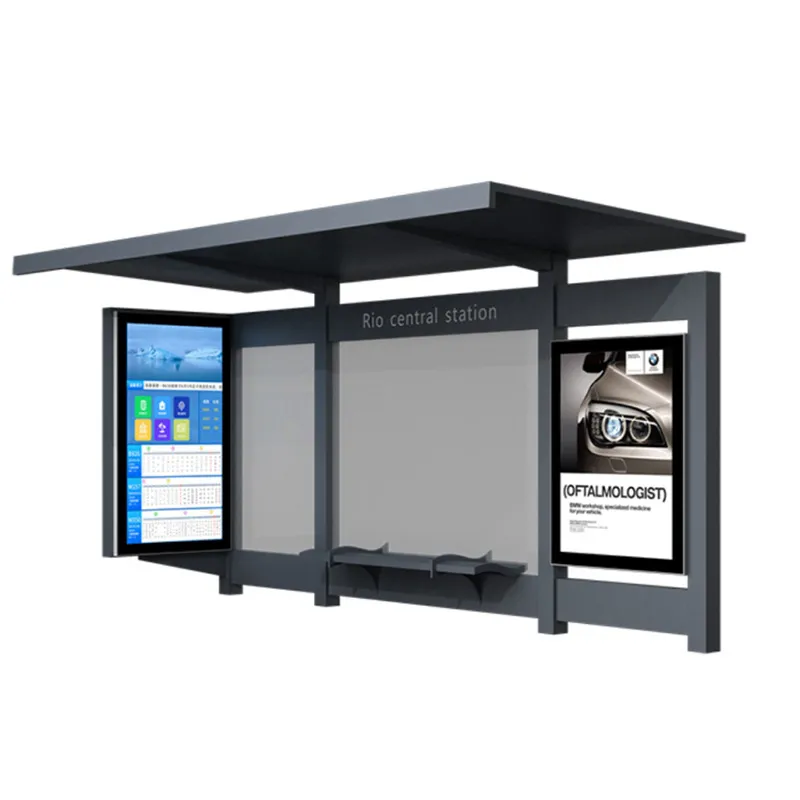- English
- Español
- Português
- русский
- Français
- 日本語
- Deutsch
- tiếng Việt
- Italiano
- Nederlands
- ภาษาไทย
- Polski
- 한국어
- Svenska
- magyar
- Malay
- বাংলা ভাষার
- Dansk
- Suomi
- हिन्दी
- Pilipino
- Türkçe
- Gaeilge
- العربية
- Indonesia
- Norsk
- تمل
- český
- ελληνικά
- український
- Javanese
- فارسی
- தமிழ்
- తెలుగు
- नेपाली
- Burmese
- български
- ລາວ
- Latine
- Қазақша
- Euskal
- Azərbaycan
- Slovenský jazyk
- Македонски
- Lietuvos
- Eesti Keel
- Română
- Slovenski
- मराठी
- Srpski језик
What Is the Purpose of a Bus Shelter?
2024-09-19
In urban and rural areas alike, public transportation plays a critical role in moving people efficiently and affordably. Whether it's a bustling city or a quiet suburban neighborhood, bus stops are an essential component of the public transit system. But one key element often overlooked is the bus shelter—a simple structure with a big impact on passenger experience and public infrastructure.
So, what exactly is the purpose of a bus shelter, and why are they so important?
Let’s explore the various functions and benefits that these unassuming structures provide.
1. Protection from the Elements
One of the most obvious and essential functions of a bus shelter is to protect passengers from the weather. Whether it’s shielding from heavy rain, snowfall, intense sun, or strong winds, bus shelters offer a safe space for people to wait comfortably. Without shelters, passengers would be exposed to harsh weather conditions, which can discourage the use of public transportation.
For example, in colder climates, waiting outside without any cover can be particularly uncomfortable. Likewise, in sunny regions, a shaded shelter offers much-needed relief from the heat.
2. Enhancing Passenger Comfort
Bus shelters often come equipped with seating, making waiting more comfortable, especially for the elderly, disabled individuals, or parents with children. Passengers waiting for long periods between buses can rest while keeping an eye on bus schedules or simply relaxing in the shaded area. Comfort is an essential factor in encouraging the use of public transit over personal vehicles, as people are more likely to opt for a bus ride if the experience is pleasant.
3. Improving Passenger Safety
A well-lit and strategically placed bus shelter increases the safety of passengers. Shelters with lighting offer better visibility during nighttime hours, reducing the likelihood of accidents or criminal activity. By providing a designated waiting area away from busy streets, shelters also create a sense of order and safety, preventing passengers from standing too close to the roadway.
Many modern shelters include transparent glass or plastic walls, allowing passersby and bus drivers to see inside, further improving security.

4. Providing Information
In addition to offering physical protection and comfort, many bus shelters are equipped with valuable information for travelers. These may include bus schedules, route maps, and updates on any delays. Some shelters even feature digital displays with real-time bus tracking, helping passengers plan their journeys with more accuracy.
5. Promoting Public Transportation
Bus shelters contribute to the overall image of the public transit system. Well-designed, clean, and functional shelters make using public transportation more appealing. By creating an organized, user-friendly waiting area, they help foster a positive perception of buses as a reliable and convenient mode of transportation.
When the experience is positive, more people are encouraged to use the bus system, reducing traffic congestion and minimizing environmental impact.
6. Advertising and Revenue Generation
Bus shelters often serve as valuable advertising space. Many are equipped with panels or billboards where companies can place ads. This not only generates revenue for local governments or transit agencies but also provides businesses with exposure to a large and diverse audience. Advertisements in bus shelters are a cost-effective way to reach commuters and pedestrians, adding to the shelter’s economic utility.
7. Supporting Social Inclusion
For individuals without access to private vehicles, public transportation is often the only option for commuting to work, school, or essential services. Bus shelters, therefore, play a crucial role in supporting social inclusion. By making the wait for public transit more comfortable and safe, shelters ensure that those who rely on buses as their primary mode of transportation are not left at a disadvantage.
8. Encouraging Sustainable Urban Design
As cities move toward more sustainable and eco-friendly infrastructure, bus shelters contribute by supporting the wider adoption of public transport. When more people use buses instead of cars, it helps to reduce carbon emissions, traffic congestion, and urban pollution. Efficient, well-maintained bus shelters are part of a holistic approach to making cities more sustainable and livable.
Conclusion
A bus shelter may seem like a small part of a city’s infrastructure, but its impact is significant. From offering protection and comfort to passengers to promoting safety and public transport usage, bus shelters are a vital component of an efficient transit system. They enhance the overall passenger experience and help create a more accessible, inclusive, and environmentally friendly urban landscape.
Next time you wait for a bus under a shelter, you’ll know that it’s not just a spot to stand in—it’s an essential part of the journey.
Ningbo Qixin Technology Co., Ltd is a high-tech private stock enterprise, engaged in industrial metal material processing. Visit our website at https://www.nbqixin-tech.com to learn more about our products. For inquiries, you can reach us at sales@nbqixintech.com.





